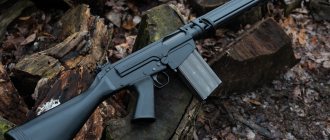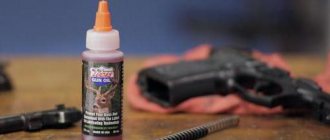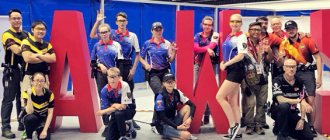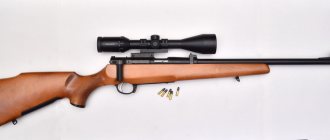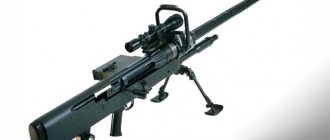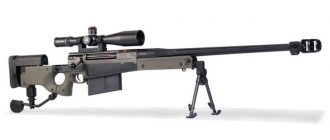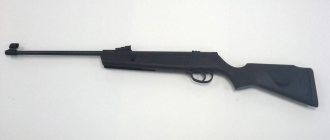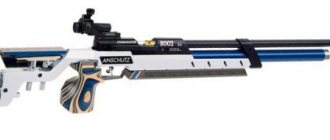The global arms market offers a wide range of shooting models. Large-caliber pistols are very popular among consumers.
Due to its high destructive power, this weapon is in demand both among law enforcement officers and among the civilian population. Information about the most powerful large-caliber pistols in the world is presented in the article.
About Desert Eagle
This large-caliber pistol is known to many. He can often be seen in Hollywood action films and computer games.
It is very popular due to its very impressive appearance and heavy weight. The weight of this shooting model, even with an empty magazine, exceeds 2 kg. Of the entire line of ammunition for this weapon, it is recommended to use Magnum-50 AE 12.7x33 RB mm caliber cartridges, which are considered the most powerful. According to weapons experts, since the 12.7 mm ammunition is machine gun caliber, the muzzle energy values of the Desert Eagle and AK-47 are approximate.
In the design of the Desert Eagle, a design was used that is characteristic not of a self-loading pistol, but of an automatic rifle. Reloading in the Desert Eagle is carried out by removing powder gases. Judging by numerous reviews from owners, the advantage of large-caliber pistols is their high power and lethality. However, Desert Eagle is not without some drawbacks. The weapon's weaknesses include its excessive recoil when firing and the formation of a muzzle flash, which interferes with quick aiming and pointing the pistol at the line of fire. In addition, the magazine is designed to only hold 7 rounds. According to the owners, the weapon requires constant care. It is undesirable to drop pistol magazines onto a hard surface, as this will result in deformation of their thin jaws. In this case, the angle of the ammunition will change. Gun owners recommend purchasing cartridges with copper casings for their pistols, the use of which eliminates delays during shooting, unlike the use of ammunition with steel casings. The pistol is used as an effective means of self-defense. Since such a weapon can even kill a bear, the Desert Eagle is in great demand among Alaskans.
Description
Fire training for American snipers, Barrett 0.50 Light Fifty Model 82A1 rifle
The development of modern large-caliber sniper rifles began in the early 1980s. Large-caliber sniper rifles are used to disable lightly armored and unarmored vehicles (vehicles on the ground and low-flying airplanes and helicopters, etc.), reconnaissance, control and communications equipment (radar antennas, satellite communications, etc.), protected firing points (shooting on embrasures and observation devices of bunkers, etc.), destruction of unexploded mines and aerial bombs. Also, large-caliber sniper rifles are used to combat enemy snipers[4].
Most often, such rifles use 12.7 mm caliber cartridges (12.7 × 99 mm NATO and Soviet/Russian 12.7 × 108 mm), borrowed from heavy machine guns, the energy reserve of which is sufficient to penetrate standard army defenses at full range bullet flight. Due to their large dimensions and weight[5], such rifles cannot fully reveal their potential in “line” units, which cannot be said about various special-purpose groups.
About the Sokolovsky model. 45
This large-caliber pistol is considered the most expensive in the world. It is produced in small batches. This weapon is characterized by the absence of all protruding parts. Upon superficial inspection, the pistol does not have any visible axles, screws, safeties or slide stops. The design of the weapon is characterized by the presence of a special shock absorber for the bolt casing, which slows down the rate of fire, and an indicator indicating that the pistol is ready for use. Mass Sokolovsky. 45 - 1630 g. The magazine is designed for 6 11.43 mm ammunition.
About AMC Auto Mag Pistols
This model is considered a serious competitor to Magnum-44 revolvers. The ammunition is based on the 7.62x51 mm 308 Winchester rifle.
The muzzle velocity of the bullet is 512 m/s. When fired, an energy of 2000 J is released. According to the owners, the pistol has very strong recoil. Ammunition is supplied from single-row magazines designed for 7 rounds. Judging by the reviews of the owners, the pistol is made of very high quality and has high combat accuracy. In addition, the weapon can be equipped with optics. The disadvantage of the model is its too high return.
In this regard, owners of such weapons are forced to hold them with both hands while shooting. From a distance of 25 meters, the bullets fall into a circle with a diameter of 3.5 cm.
Improved 40mm high-velocity high-explosive projectiles HV HE/HEDP (High Velocity High Explosive Cartridge) from RheinmetallRheinmetall's HV (High Velocity) projectiles use a proven, proprietary propulsion system that provides very low muzzle velocity standard deviation, resulting in increased accuracy. Having a constant muzzle velocity, training and HE/HEDP (High Explosive/High Explosive Dual Purpose) projectiles can reach a maximum range of 2200 m with any 40 mm standard automatic grenade launcher (AG).
After the laser range finder of the AG fire control unit points to the target, the infrared programming unit gives the IR beam information about the detonation time. When a projectile is fired, an undamped IR beam programs the ammunition in flight, indicating the time of detonation, that is, air detonation (all high-explosive high- and medium-velocity Rheinmetall projectiles can be equipped with an available noise-immune air detonation fuze with a time delay). After programming, the data receiving system closes. If the projectile is not programmed, the fuze operates as an electromechanical point detonation system. This ammunition is mainly intended for operations in urban areas, in open areas and when firing at indirect fire. 40mm x 53 HEDP can penetrate 80mm of homogeneous armor. According to Franz von Stauffenberg, head of the 40 mm ammunition division at Rheinmetall Defense, “no other product can do the same.”
The HV HE/HEDP ammunition has a valid maximum range of 2200 m and has passed advanced qualification testing in Canada (exorbitantly expensive but necessary tests). One of the most difficult of the more than forty tests (including periodic shock, impact weight loss, temperature cycling, etc.) was the vibration test, which the German procurement agency said passed “the best; There’s never been anything like this before.” After all these tests, the company can say that their high explosive projectiles meet the latest environmental specifications for vibration in helicopters and aircraft, long-term storage, etc., while the fuze meets the safety requirements of STANAG 4187. Equipped with an electronic self-destruct mechanism and an improved function point detonation, these ammunition also remain highly reliable at temperatures from -46°C to +63°C.
In addition, the HV HE/HEDP projectile with point detonation can be fired from mixed cartridge belts loaded with 40x53mm HE and 40x53mm HEDP.
According to Stauffenberg, his company's goal together with Vinghog, a division of Rheinmetall Nordic, is to increase the probability of a first-shot hit, for example with the help of the VINGMATE fire control system. He added that based on the results of these tests, Rheinmetall was able to prove that its ammunition has greater range and greater lethality than competitors and that it is “more cost effective due to its low cost.”
25×59 mm AMR materiel weapon
This type of weapon is lighter and simpler than those AMRs that are designed to fire artillery ammunition. However, the XM109 rifle currently under development from Barrett fires a 25x59 mm projectile; the purpose of its creation is to obtain a highly mobile weapon system capable of breaking through doors and walls, hitting light armor, IEDs and enemy personnel. Barrett is working with GDOTS to further develop the system, consisting of the XM109 and the XM1049 HEDP dual-use high-explosive projectile. The rifle is based on the Barrett M107 model, they cost about 5,000 in service and are easily converted to a larger caliber using simple components. GDOTS' LW25 line also includes a high explosive point detonation round and a low-cost, production-ready practical round.
Originally designed for use in the 25mm ATK BUSHMASTER Chain Gun, these rounds offer 70-85% of the lethality of the larger and more powerful 25mm M792 and 30mm M789 rounds at comparable load weights. ATK's LW25 line consists of training, blank, high-explosive incendiary, high-explosive dual purpose (HEDP) and PABM (Programmable Fuzed Airburst Munitions) ammunition, along with blank, non-lethal and practical marking rounds.
The LW25 PABM project is in the qualification phase and is scheduled to be completed in 2012, immediately following performance, safety and environmental testing. For economic reasons, preference is given to a projectile with a fuse in the middle between the two warheads with controlled formation of fragments.
The fuse uses inductive programming technology, originating from the 30mm ATK PABM-T projectile. It has three modes: air blast, point detonation and delayed point detonation. If something goes wrong during programming, the fuse is automatically set to point detonation mode. All modes are effective out to 2000 m, and the pinpoint detonation sensitivity is set such that an impact with a 0.063 inch (~1.6 mm) thick aluminum plate will cause the projectile to detonate.
Shooting product from Freedom Arms
Casull has high lethal properties: a 45-caliber Magnum revolver. The ammunition was based on the 454 cartridge case, which was used to equip the Colts. This ammunition was equipped with such a strong powder charge that the gunsmiths decided to create a revolver with a special design that could withstand high pressure. The Casull became such a revolver. High-strength steel is used to make weapons. The muzzle energy indicator is 2000 J. Since the design of the revolver has no moving parts, during its operation the shooter often has problems associated with very strong recoil. In order to somehow reduce it, gunsmiths provided a weakened powder charge for the cartridge. The price of such a revolver: 1960 dollars.
About the California hand grenade launcher
San Ramon, California is home to the powerful Gyrojet revolver. Initially, American designers created weapons that fired small missiles. They stabilized in flight, rotating around their longitudinal axis. Later, a special manual launcher was developed, which became the Gyrojet revolver. Unlike other models that use bullets, the operation of this weapon involves the use of special missiles. Their diameter is 13 mm. The ammunition is equipped with solid warheads and tubular stabilizers, which contain explosive material inside. A Venturi plate is used to cover the bottom of the stabilizer. Rockets have both translational and rotational motion. This became possible thanks to the presence of four nozzle holes in the Venturi plate. There is also a place for the igniter primer. Externally, the Gyrojet manual starting device looks like a large-caliber revolver. The weight of a revolver designed for 6 shots is 450 g. With a caliber of 13 mm, according to experts, this can be considered an advantage of the model. However, apart from high lethality and lightness, the weapon cannot “boast” anything else.
According to experts, compared to a conventional pistol, the Gyrojet has low combat accuracy. At a distance of 10 yards, the bullets disperse 11 inches in diameter when fired.
Russia has created the lightest large-caliber rifle in the world
Russian special forces will receive a unique large-caliber sniper rifle "Kord-M", which will allow special forces soldiers to hit enemy personnel and light armored vehicles at a distance of up to 2 km. The relatively light weight of a weapon with such characteristics - only 10 kg - will allow special forces to make multi-kilometer forced marches with the new rifle.
Currently, Russian special forces snipers are armed with large-caliber ASVK Kord sniper systems, which, with a length of 1.5 m, weigh more than 12 kg. An experienced sniper uses the Kord to hit targets at a distance of up to 1.5 km.
“Kord-M” was created on the basis of ASVK, but thanks to the use of new technologies and materials, as well as a new design, the weight of the weapon was reduced to 10 kg, increasing the target firing range to 2 km. ASVK-M can penetrate armor up to 15 mm thick, concrete walls and brickwork.
The Kord-M high-precision sniper system is also known under the designations ASVK-M and 6V7M-1. The rifle was developed by the Kovrov Plant named after Vasily Degtyarev (ZiD). The new product turned out to be lighter than its foreign competitors (in particular, the American M82, which is in service with almost all special forces of the developed countries of the world), and, according to the first reviews, it also surpassed its foreign analogues in terms of aimed firing range.
“At present, ASVK-M is completing tests,” said a representative of the military department familiar with the situation. — At the beginning of 2017, the first products will enter service with special forces units and units, as well as the Airborne Forces, and will later replenish the arsenal of snipers in mountain rifle brigades.
— A large-caliber sniper rifle should not be too light. After all, the heavier the rifle, the better it, due to its mass, absorbs very strong recoil when shooting, said the sniper officer. “For example, the recoil of a conventional Kord is several orders of magnitude greater than the recoil of an AK-74 assault rifle. And the recoil of a large-caliber complex has a negative impact on human health. In particular, when shooting for a long time, your kidneys suffer and you get the feeling that you’ve been hit on the head. In Kord-M, the designers managed to find a reasonable compromise, and the weight reduction did not lead to an increase in recoil.
According to the interlocutor, the standard Kord is a good rifle with excellent accuracy. But it is more suitable for snipers of motorized rifle brigades and divisions, which mainly travel in armored vehicles.
“When operating behind enemy lines, special forces carry all their weapons on their shoulders, so the mass of weapons is one of the most important factors in the success of special forces operations,” explained the sniper officer.
The world's leading developers of sniper systems are constantly working to reduce the weight of their large-caliber products. But so far no one has been able to “squeeze” them to 10 kg. So, if the Barrett M82 weighed about 13 kg, then the newest Barrett XM500 lost weight to 11.8 kg. And the weight of the British “sniper” AS50 from Accuracy International, compared to the earlier AW50, fell by only 900 g - to 14.1 kg. It is noteworthy that the effective firing range of the M82 and XM500 is just over 1100 m, while that of the AS500 and AW50 is about 1500 m.
“At the present time, when massive offensives are being replaced by targeted attacks by sabotage groups, special forces fighters especially need rifles with which they can hit a wide range of targets from a long distance. At the same time, the weapon must be light and compact enough so that it does not prevent the sniper from quickly leaving the place from which the shot was fired, said Alexander Grek, editor-in-chief of the Popular Mechanics magazine. — Until recently, the creation of such weapons caused a number of difficulties - as a rule, large-caliber rifles turned out to be quite heavy and had strong recoil. But to date, the use of more advanced muzzle compensators and progress in the creation of new alloys and ammunition have allowed manufacturers to significantly lighten their products while maintaining their range.
About the Thunder 50 BMG pistol
The weapons are manufactured by the American company Triple Action LCC. In an effort to create the largest caliber pistol, the designers decided not to use pistol cartridges. The experiments were carried out with conventional ammunition used for the 50 BMG large-caliber sniper rifle. Chuck size: 12.7x99 mm. The weapon created on its basis is listed as Thunder 50 BMG. The model was first presented in 2004 at the SHOT Show.
The pistol is single-shot. Its design is distinguished by the presence of a muzzle brake and a hydraulic system, rare for such weapons, that rolls back the barrel, thanks to which recoil during shooting is reduced by almost 20%. The muzzle energy indicator is 15,500 J. The disadvantage of the weapon is the formation of a flame that is knocked out through the slots of the compensator. The range of the flame knocked out during firing can reach five meters. This makes it much more difficult to quickly aim the weapon at the next target.
Large-caliber sniper rifles of some foreign countries (2017)
Captain A. Zakhartsev, Captain A. Vasiliev
In addition to sniper rifles of 5.56 and 7.62 mm calibers, which are widely used in the armed forces (AF) of many countries, in recent years there has been an increased interest of the military leadership in equipping units of the Armed Forces and other law enforcement agencies with large-caliber rifles (12.7, 14.5, 15, 2 and 20 and 25 mm) sniper rifles (SSV).
This interest is due to the fact that the CSV, in addition to conducting counter-sniper combat and destroying manpower and combat equipment in field fortifications and in urban environments, allows you to disable unarmored and lightly armored equipment, aircraft and helicopters in parking lots, missiles on launchers (PU) , radar stations, surveillance, communication and control equipment, openly located ammunition and explosive devices.
CSVs have become one of the main weapons systems for special purpose units, security, destruction of unexploded ordnance and explosive devices, allowing them to solve problems while being at a considerable distance from the target.
The development and production of large-caliber rifles is currently established in several countries, namely the USA, Great Britain, France, Australia, Austria, Hungary, China, Poland, Serbia, Switzerland, the Czech Republic, Croatia, and South Africa. Structurally, SWRs are made according to the classical scheme or according to the “bullpup” scheme with the location of some of the moving parts of the rifle in the butt. Using the latest layout allows you to make the weapon more compact.
To reduce recoil energy to the level of conventional small arms, the SWR can use a muzzle brake, recoil devices, a spring damper, and a shock-absorbing pad on the back of the butt.
For ease of aiming and greater stability when shooting, many large-caliber sniper rifles have a folding bipod, and some have the ability to adjust the design elements taking into account the individual characteristics of the shooter.
The combat weight of large-caliber sniper rifles, depending on the caliber, ranges from 6.3 to 29 kg, the length in the firing position is from 1110 to 2015 mm, the initial bullet speed is from 720 to 1460 m/s, the effective firing range is from 1000 up to 1,300 m, magazine capacity up to 20 rounds. The ammunition used is 12.7x57 mm, 12.7x99 mm, 12.7x107 mm, 14.5x114 mm, 15.2x170 mm, 15.2x207 mm, 20x82 mm, 20x83.5 mm, 20x110 mm and 25x59 mm.
Currently, the following SSV models have the highest technical level and, accordingly, combat capabilities: the Barrett (), Windrunner, Shilon, SR-50 and Namessis series.
The most widely used large-caliber sniper rifles of the Barrett series are the M82A1, M32A2 and M82A3, which in addition to the United States are currently used in 34 other countries.
| М82А1М (М107) |
| "Barrett" M-99 |
| XM109 |
| AW.50 |
| Robar 50 BGM |
12.7 mm SWR M82A1M (M107)
was developed mainly for use during battles in populated areas. The M82AZ SASR (Special Applications Snipe Rifle) variant was created on the basis of the basic model specifically for the Marine Corps.
12.7 mm SSV "Barrett" M-99
— single-shot, made according to the “bullpup” design, is a lightweight “Barrett” model. Adopted by units of the Special Operations Forces Command (SOF) of the US Armed Forces.
When designing the 25 mm SWR XM109
Minimal changes were made to the design. The barrel, upper receiver and magazine were modified. In fact, the XM 109 rifle can be obtained by replacing the above components in the M82/M107 series rifle.
Based on the base model M82A1, a 25-mm sniper rifle was created, called the Barrett Payload Rifle. The SSV uses 25 x 59 mm ammunition designed for weapons designed to engage enemy targets at ranges of up to 2,000 m.
In a series of large-caliber sniper rifles, the single-shot base model M-87 is being developed, on the basis of which, in turn, a series of rifles will be created, including the M-87R, equipped with a five-round magazine; its layout is also used in the M-88 “Combo” model and in the M-92 (the latter is created according to the “bullpup” design).
A 12.7 mm M-93 rifle was also created. This is an improved version of the M-87K with a folding stock, reducing the overall length from 1,346 mm to 991 mm. It uses a 10 or 20 round magazine. Its combat weight is 6.3 kg, and its firing range is similar to that of other large-caliber sniper rifles from this company.
developed a large-caliber (12.7 mm) Windrunner rifle, which has a small weight and size, as well as a butt adjustable in length.
Rifle "Shilon" (model 400)
, designed for the 10.4 x 77 mm cartridge, is loaded manually from a five-round magazine. Analysis and evaluation of the performance characteristics of the SWR showed that during tests, when firing five rounds, all bullets hit the training target - a circle with a diameter of 12 cm at a distance of 1,400 m, and the aimed firing range reached 2,300 m. The rifle has a length of 1,380 mm and a weight of 8 .5 kg.
12.7 mm large-caliber sniper rifle SR-50
has a box magazine with a capacity of 10 rounds, which is placed horizontally on the receiver on the left.
12.7 mm SWR "Namessis"
is being developed on instructions from the US SOF command. It is a lighter version of the weapon of the French Hekate-2 series of rifles, has a five-round detachable magazine, manual reloading, and allows you to quickly replace the standard 700 mm barrel with a 400 mm silencer. The combat weight of the rifle is 10-13 kg.
In the UK, large-caliber sniper rifles are produced: 12.7 mm AS-50
— self-loading, with a folding stock and a detachable five-round magazine, weight 14 kg; The 12.7 mm AW.50 is five-round, has two models - AW.50F and AW.50FT, differing in length and weight.
Rifle AW.50
equipped with a recoil device, adjustable butt pads and butt cheeks.
In France, large-caliber sniper rifles are being developed by Guitte, PRA, and Stopson Robar.
Rifle "Hekate-2"
with manual loading has a modular design and can be used with a conventional or composite stock. The barrel is provided with a heat-absorbing coating. Adopted by special forces and other law enforcement agencies of France. Caliber 12.7 x 99 mm, weight 13.8 kg (without sight), length 1,380 mm; target firing range 1,800 m.
Weapon "Guitte 50"
is a series of 12.7 mm bullpup rifles with manual loading and different barrels for shooting at different distances. The 12.7 mm SSV "Antis" is designed for standard and low-noise cartridges.
12.7 mm "Robar 50 BGM"
A manually loaded, five-shot sniper rifle, seen as perhaps the most effective weapon option for snipers.
12.7 mm sniper rifle "Rendon Monster"
, manufactured by PRA, five-round, with a folding stock, which makes it easy to transport, despite the long barrel. The combat weight of this SWR is 15 kg. There is a standard 6-24 x 72 optical sight.
Foreign military experts note that large-caliber sniper rifles with improved firing characteristics and, accordingly, increased combat capabilities are expected to appear in the near future. Existing models will also be modernized in order to increase power and more efficient use. In addition, it is possible to create fundamentally new SWR samples.
Foreign military review. 2020, No. 3 P. 54-57
About the TRR8 revolver
This pistol model is familiar to consumers as a Smith Wesson. The weapon was designed for special forces personnel. The revolver is equipped with a frame on which an optical sight is mounted. There is space under the barrel for a tactical flashlight. The Smith Wesson drum is chambered for 8 Magnum 357 rounds, which are much more powerful than standard 9mm pistol rounds.
Single action trigger mechanism. According to TRR8 owners, this weapon, compared to many semi-automatic pistols, is highly accurate. The Smith Wesson, like all revolvers, has one drawback: the reloading process is too labor-intensive.
About the Perfect 10, Colt Delta Elite and Glock 20 Shooting Models
Judging by numerous reviews from owners, the Perfect 10 large-caliber pistol has high destructive power and a stylish design, traditional for the Colt 1911. The Perfect 10 is equipped with a classic adjustable sight. Shooting is carried out with 10 mm cartridges, which are contained in a magazine designed for 7 rounds. Another one is located in the barrel of the pistol. Unlike the Colt Delta Elite and Glock 20, the Perfect 10 is more ergonomic and has a modular design. Even though the Glock 20 is cheaper, it cannot be equipped with electronic sights. According to weapons experts, the Colt has good ergonomics. In addition, its cost is low. However, the weapon is equipped with only nine rounds: 8 rounds are contained in the drum and one in the barrel.
"Hit"
In the city of Klimovsk, the designers of TsNIItochmash designed the Russian large-caliber revolver “Udar”. The weapon has a rather outdated reloading scheme: in order to equip the revolver with ammunition, the shooter must remove the drum. The weapon was first introduced in 1993. The base for 12.3 mm cartridges for this model was 32-caliber hunting ammunition. The brass case of the model is equipped with a powder charge and a KV-26 igniter primer. Klimov gunsmiths produced a line of cartridges for the “Udar” revolver. The ammunition could contain live, paint, rubber and armor-piercing shells. Cartridges were produced in pyro-liquid, shot and light-sound types. The bullets have a high stopping effect. The advantage of armor-piercing charges is that, having pierced a wall, door or glass, they do not ricochet at all. From 25 meters, such a bullet easily penetrates a steel sheet 0.5 cm thick. According to reviews from owners, the “Udar” is balanced and equipped with a very comfortable handle. Unlike the Makarov pistol, the accuracy of the revolver is one and a half times higher. When shooting with a plastic bullet, it is guaranteed to hit the silhouette of a person from 15 m.
Representatives
| Name | A country | Cartridge | Automation |
| Accuracy International AS50 | Great Britain | 12.7×99 mm | Removal of powder gases, bolt misalignment |
| Accuracy International AW50 | Great Britain | 12.7×99 mm | Rolling shutter |
| AR-50 | USA | 12.7×99 mm | Rolling shutter |
| AM50 | Iran | 12.7×99 mm | Rolling shutter |
| AMR-2 | China | 12.7×108 mm | Rolling shutter |
| Barrett M82 | USA | 12.7×99 mm | Short barrel stroke, rotary bolt |
| Barrett M90 | USA | 12.7×99 mm | Rolling shutter |
| Barrett M99 | USA | 12.7x99mm .416 Barrett | Rolling shutter |
| ČZW-127 | Czech | 12.7×99 mm | Semi-blowback |
| DSR 50 | Germany | 12.7×99 mm | Rolling shutter |
| Falcon | Czech | 12.7×99 mm | Rolling shutter |
| Gepard | Hungary | 12.7×99 mm | Rolling shutter |
| M99B/M06 | China | 12.7×108 mm | Removal of powder gases, bolt misalignment |
| IST 14.5 Istiglal | Azerbaijan | 14.5×114 mm | Rolling shutter |
| IST 12.7 Mubariz | Azerbaijan | 12.7x108 mm | Rolling shutter |
| SGM-12.7 | Ukraine | 12.7x108 mm | Rolling shutter |
| NST 14.5 | Azerbaijan | 14.5×114 mm | Rolling shutter |
| Mechem NTW-20 | South Africa | 14.5×114 mm 20×83.5 mm 20×110 mm | Rolling shutter |
| OM 50 Nemesis | Switzerland | 12.7×99 mm | Rolling shutter |
| PGM Hecate II | France | 12.7×99 mm | Rolling shutter |
| Pindad SPR-2 | Indonesia | 12.7×99 mm | Rolling shutter |
| QBU-09 | China | 12.7×108 mm | Rolling shutter |
| Remington 700 | USA | 12.2×82.6 mm | Rolling shutter |
| RT-20 | Croatia | 20×110 mm | Rolling shutter |
| Steyr HS .50 | Austria | 12.7×99 mm | Rolling shutter |
| Steyr IWS 2000 | Austria | 15.2×169 mm | Long-stroke recoil |
| Truvelo .50 | South Africa | 12.7×99 mm | Rolling shutter |
| Truvelo 14.5 | South Africa | 14.5×114 mm | Rolling shutter |
| Truvelo 20×82 | South Africa | 20×82 mm | Rolling shutter |
| Truvelo 20×110 | South Africa | 20×110 mm | Rolling shutter |
| WKW Wilk | Poland | 12.7×99 mm | Rolling shutter |
| Arash | Iran | 20×102 mm | Rolling shutter |
| ASVK | Russia | 12.7×108 mm | Rolling shutter |
| Borbalo-213 | Georgia | 12.7×108 mm | Rolling shutter |
| Vidhwansak | India | 12.7×108 mm 14.5×114 mm 20×82 mm | Rolling shutter |
| Outpost M12 “Crno kope” | Serbia | 12.7×108 mm | Rolling shutter |
| Zastava M93 "Crna Strela" | Serbia | 12.7×108 mm | Rolling shutter |
| Zulfiqar | Yemen | 23×152 mm | |
| K-15 | Armenia | 12.7×108 mm | Rolling shutter |
| OSV-96 | Russia | 12.7×108 mm | Powder gas removal, rotary bolt |
| OTs-44 | Russia | 12.7×108 mm | Powder gas removal, rotary bolt |
| PDSP | Georgia | 12.7×108 mm | Powder gas removal, rotary bolt |
| PDShP-2 | Georgia | 14.5×114 mm | Rolling shutter |
| Satevari | Georgia | 12.7×108 mm | Rolling shutter |
| Taktab | Iran | 14.5×114 mm | Rolling shutter |
| Shaher | Iran | 14.5×114 mm | Rolling shutter |
| Separatist | DPR | 23 × 152 mm | Rolling shutter |
| Zijiang M99 | China | 12.7×108 mm | Rolling shutter |
About Tula large-caliber weapons
In 1994, the designers of the Tula KPB released a new large-caliber revolver, which is also listed as “Udar”. The design of the weapon includes a one-piece streamlined frame, a double-action trigger mechanism and a drum that flips to the left. You can shoot by self-cocking or cocking the hammer. The 12.3x40 mm cartridges are based on 32-caliber hunting ammunition. The revolver drum is designed to hold 5 rounds. Dimensions of the Tula large-caliber model: 172x44x136 mm. When equipping the drum, the shooter used a special clip. It consists of two plates containing special cutouts for cartridges. With the help of this clip, the extraction of already fired cartridges is also carried out. The mass of the Tula revolver “Udar” is 0.92 kg.
Large-caliber rifles "Steyr"
The Austrian company, part of the Steyr-Daimler-Puch AG concern, could not stand aside when at the end of the 20th century. The popularity of large-caliber weapons has increased dramatically. In the mid-1980s. The company's engineers began developing a new type of infantry support weapon for the Austrian army from the Anti Materiel Rifle class. The rifle, capable of hitting lightly armored vehicles, light fortifications, control posts, low-flying helicopters, etc., at a range of up to 1000 m, had to be served by a crew of 2 soldiers.
Initially, the weapon was created chambered for a 12.7 mm caliber cartridge, similar to the standard NATO .50 BMG cartridge. However, it was soon decided to use more powerful APFSDS type ammunition (OBPS - feathered armor-piercing sub-caliber projectile). As the name implies, the bullet of such ammunition has the form of a feathered arrow made of tungsten alloy - a material extremely popular among developers of small armor-piercing weapons.
In 1990, the large-caliber semi-automatic shotgun AMR 5075 (namely a shotgun, since the barrel had no rifling) of 14.5 mm caliber was introduced. This experimental weapon was produced only in a small series, most of the copies were sent to the military for testing. The tests ended quite satisfactorily, the army showed interest in weapons of this type, however, no orders followed.
Read: Rifle "Galil"
Meanwhile, Steyr engineers continued to develop the theme, preparing a new, more powerful project. At the end of the 1990s. A modification of the AMR 5075 appeared, converted to a larger 15.2 mm caliber cartridge of the APFSDS type (i.e., the same “armor-piercing arrow”). The weapon was designated "Infantry Weapon System 2000" (abbreviated as IWS 2000).
The weapon is structurally a smooth-bore semi-automatic shotgun equipped with a 5-round magazine (the prototype, the AMR 5075 shotgun, used 5- and 8-round magazines). The weapon's effectiveness is quite impressive. At a distance of 1000 m, a bullet (more precisely, an arrow) pierces an armor plate 40 mm thick, and this is with effective armor fragmentation. The high initial speed and stability of the arrow flight provide good flatness of flight and good shooting accuracy for this caliber. At a distance of 1000 m, the bullet’s flight path does not rise above 800 mm above the aiming line.
Needless to say, shooting at enemy soldiers (i.e. anti-sniper use of a gun) due to the enormous power of the cartridge is very effective, although extremely wasteful in terms of cost/effect produced. Like shooting sparrows from a cannon.
Tactical and technical characteristics of large-caliber rifles "Steyr"
Currently, the IWS 2000 system is ready for deployment and mass production. However, serial production has not yet been announced. The weapon is very massive and, apparently, not cheap. In addition, a serious obstacle to adoption is a completely new non-standard cartridge (and, judging by the materials used and the complexity of the design, very expensive). Until recently, the company's plans included creating weapons with an initial bullet speed of 1500 m/s, as well as experiments with rifled barrels.
Read: NSV-12.7 “Cliff”
However, it seems that the following fact puts an end to the fate of this gun, which is quite remarkable in all respects. In February 2004, at the SHOT Show 2004 arms exhibition in Las Vegas (USA), the Steyr .50 HS large-caliber sniper rifle was presented at the stand for the first time. Already by the name it is clear that the weapon was created for the old proven .50 BMG cartridge (12.7 × 99 mm). The declared effective firing range is 1500 m, the purpose is “anti-sniper” and “anti-material” shooting. This is a standard, well-made, but unremarkable large-caliber rifle, of which there are many today. Its appearance, apparently, symbolizes the refusal of developers from non-standard solutions, such as the AMR 5075 and IWS 2000 shotguns, in favor of more familiar and commercially effective ones.
You might be interested:
- Submachine gun "Steyr-Solothurn" S1-100/MP 34
- Assault rifle "Steyr" AUG 77
- Submachine guns "Steyr" MP 69 and MP 81 (Austria)
- Pistols "Steyr" (Austria)
- Revolvers "Astra" (Spain)
- Automatic "AUG"
Subscribe to
our channel in Yandex.Zen
About the assault RSh-12
As part of the Exhaust program, the developers designed new models of small arms for special forces. The RSh-12 is considered one of the very effective large-caliber pistols in Russia. The weapon is designed for STs-130 12.7x55 mm ammunition. According to experts, the RSh-12 is the largest caliber pistol in the world. According to reviews from owners, this weapon is light, compact, very powerful and quite accurate. In these parameters, the RSh-12 surpassed other small arms models of similar sizes available on the civilian arms market. The pistol is equipped with a special clip-on buttstock and a front handle, which ensure a secure hold of the weapon during shooting.
In addition, the revolver is equipped with special Picatinny rails, with the help of which a flashlight, laser designator, collimator or optical sights are installed on it. According to experts, the lethal qualities of this pistol are not inferior to the most powerful hunting carbines. High performance with low weight and dimensions are considered the strengths of the RSh-12.
Story
Russian ASVK
The ancestors of this class of weapons can be considered heavy serf guns, used in the 19th century, for example, by Russian troops near Plevna during the Russian-Turkish War of 1877-1878. During World War I, the British used rifles chambered in the heavy-duty .600 Nitro Express hunting cartridge to engage targets behind armored trenches. And the Germans developed the world's first anti-tank rifle to fight British tanks - the Mauser T-Gewehr chambered for a special 13.25x92 mm SR cartridge, which laid the foundation for modern cartridges for large-caliber army small arms.
During the Second World War, anti-tank guns became widespread, for example, the Soviet PTRS and PTRD, which, according to the modern classification, can be safely classified as large-caliber rifles, but low accuracy (~5-7 MOA, with ≤2 MOA acceptable for snipers) does not allow consider them snipers. After the end of the war, this class of small arms practically ceased to exist due to a sharp increase in the armor of the military equipment it was intended to destroy.
In 1942, an experimental 14.5-mm anti-tank rifle of the ZIF type, which had an optical sight, was developed in Leningrad. Later, shortened versions of the ZIF-11, ZIF-11A and ZIF-11B were positioned as “armor-piercing sniper rifles” as opposed to the Finnish Lahti L-39, which were allegedly used as a sniper weapon on the Leningrad front[3].
The first rifle of the “new wave” was the American M500, created by Research Armaments Prototypes (RAP) in 1981-1982 for the US armed forces, but real fame came to the new type of weapon only after the successful use of the Barrett M82 (“Light Fifty”) during wars in the Persian Gulf.
